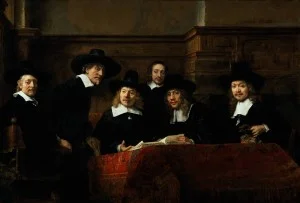Rembrandt's Later Years
The disappointment from the loss of his wealth, the sale of his house and the auction of his possessions affected Rembrandt’s work. The nature of what he painted changed to a more tragic subject matter. But despite this, his artistry increased and some of his greatest paintings came from this time period. Examples are Bathsheba that he painted in 1654, and The Jewish Bride painted in 1665.

Bathsheba at Her Bath, 1654; Louvre, Paris

The Jewish Bride (Portrait of Two Figures from the Old Testament), 1667; Rijksmuseum Amsterdam
Later in Rembrandt’s life, his personal sorrows continued. Most of the wealth that he had spent years gaining was lost, and his common-law wife, Hendrickje Stoffels, died from the plague in 1663. Then in 1668 his beloved son Titus died at only 27 years old. However, these problems in no way affected Rembrandt’s work, and, if anything, his artistry increased.
A year before his wife’s death, he painted The Sampling Officials of the Amsterdam Drapers’ Guild (1662), and received some major commissions from wealthy families.

The Sampling Officials of the Amsterdam Drapers' Guild, 1662; Rijksmuseum Amsterdam
Within a year of his son Titus’s death, Rembrandt painted three self portraits. On October 4, 1669, Rembrandt died in Amsterdam. He was buried in the Westerkerk four days later in an unmarked grave. His actual cause of death is not listed in his biographies, but there is one reference that he died of temperal arthritis. After his death, Painter Christiaen Dusart was appointed guardian of Rembrandt’s daughter Cornelia van Rijn, and hailed Rembrandt as “the miracle of our age.”